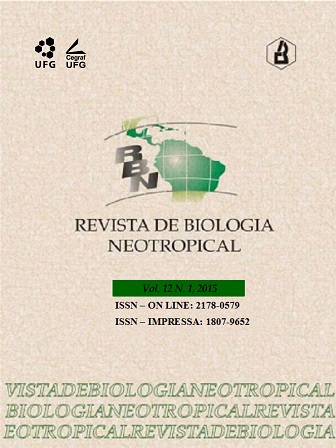Influence of different methods of ecological restoration on the bird assemblage of a subtropical agroecosystem in Brazil
Keywords:
Subtropical forests, Mata Atlântica, restoration ecology, ecological succession, neotropical birdsAbstract
Ecological restoration allows manipulation of the complexity and heterogeneity of the landscape, which are decisive for the structuring of animal communities. In this sense, in the first chapter ofthis study, diversity parameters of the bird assemblage were evaluated in experimental plots using three ecological restoration techniques: nucleation (NC), passive restoration (PR) and high diversity planting (HD). In the second chapter, we tested the hypothesis that artificial perches used in ecological restoration are crucial for promoting increased richness and diversity of birds in plots restored through nucleation. In addition, we investigated the ability of different restoration techniques to attract birds occurring in nearby forest experiment. In the third chapter, we tested the hypothesis that the structure of the birdassemblage using artificial perches for birds is affected by seasonal variation. The three chapters werebased on data from 12 experimental plots established in a subtropical agroecosystem being restoredin the southwestern state of Paraná, Brazil. Mostly ANOVA was used to compare parameters that makeup the diversity. Moreover, the description of the structure and composition of the bird assemblage wasdone by means of specific tests used in biodiversity studies. In the first chapter, the greatest richnessof birds occurs through nucleation (49 ± 2.45 SD species) and the lowest richness occurred in the HD treatment (37 ± 3.14 SD species), with a similar statistical pattern for abundance and diversity (NC > PR > HD). The functional pattern of nucleation shows that the method responds favorably to cases of dynamic equilibrium, heterogeneity and complexity of the landscape. However, in the second chapter, when the results obtained solely from artificial perches are disregarded, the pattern of the componentsof bird’s diversity in the applied nucleation does not differ from that of the passive restoration. High diversity planting had the highest similarity the richness and diversity of avifauna between restoration procedures as regards to the nearby forest, demonstrating that it may have greater medium-term conservation potential. Data from the artificial perches (Chapter 3) showed that they were ineffective inattracting frugivorous birds, reinforcing that seed dispersal tends to be done primarily by insectivores and generalist omnivores in subtropical agroecosystems, where the richness of the disperser assemblage can be affected by seasonal variation.
Downloads
Downloads
Published
How to Cite
Issue
Section
License
The expontaneos submmition of the manuscript automaticaly implies in the cession of all patrimonial rights for the Journal of Neotropical Bilogy (RBN) after publication. The autor allow the right of first publication of the article to the RBN, under Creative Commons Attribution 4.0 (CC BY-NC 4.0) Licence.
There are garanties for the authors to the authorial and moral rights, for each one of the articles published by RBN, with permissions:
1. The use of article and contents for the education and researches.
2. The use of the article and their contents, linking to the Article on the web site of the RBN, allowing the divulgation on:
- institutional closed web (intranet).
- open access repositories.
3. Preparation and divulgation of the other publication derived from the article and its content, if there is citation of the original publication by RBN.
4. Make printed copies in small quatinties for personal use.

















